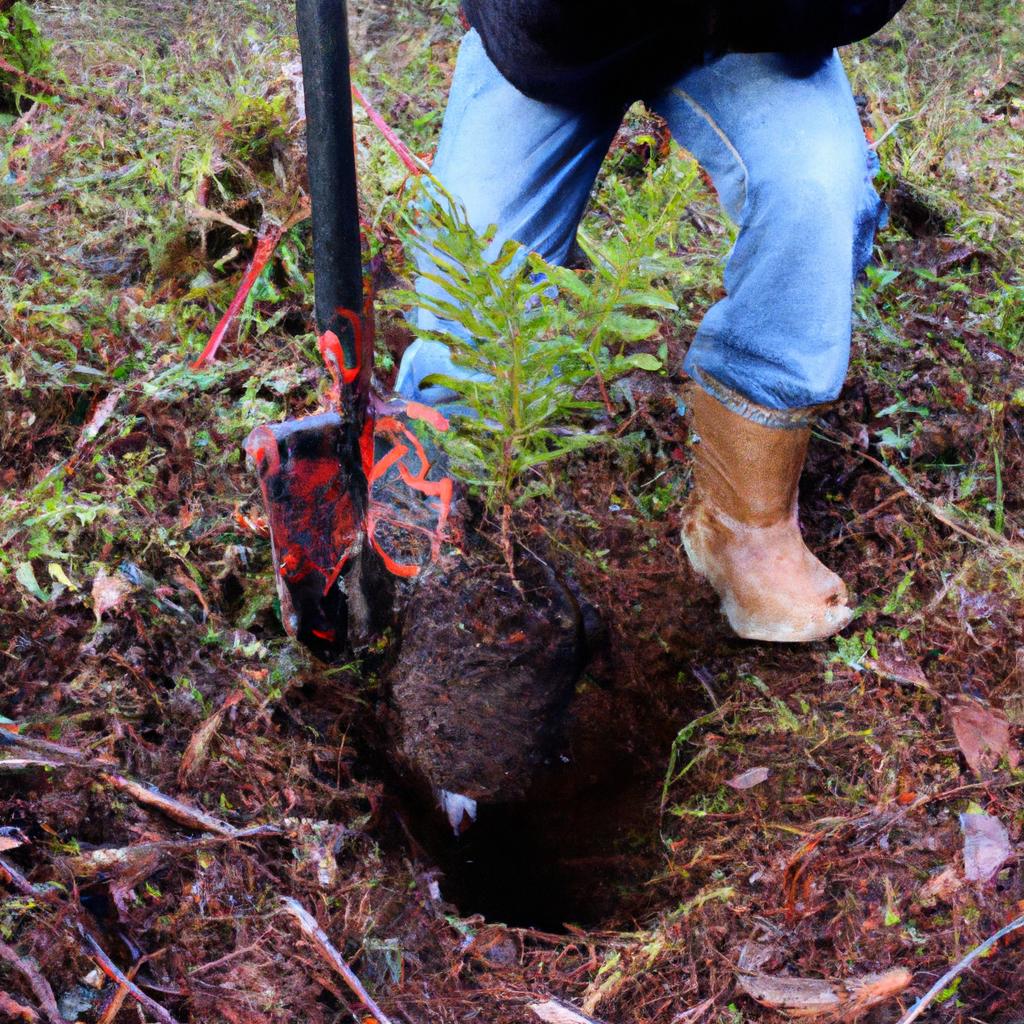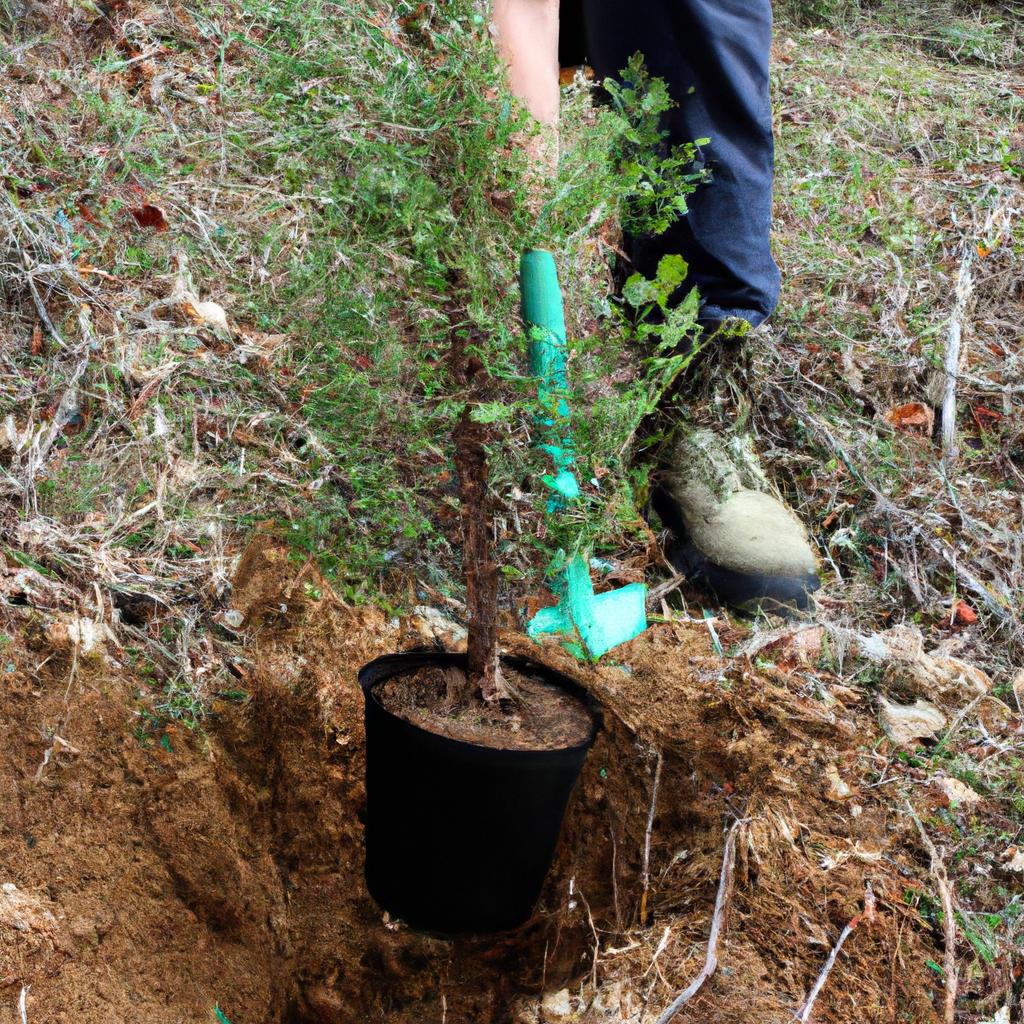In recent years, the concept of sustainability has gained significant attention and recognition worldwide. As societies become more aware of the detrimental impact of human activities on the environment, there is an increasing demand for environmental education to promote sustainable practices. One compelling example that highlights the importance of such education is the case study of a small coastal town facing severe water scarcity due to overconsumption and mismanagement. The implementation of comprehensive environmental education programs in this community not only raised awareness about responsible water usage but also empowered individuals to adopt sustainable behaviors.
The significance of environmental education lies in its ability to foster knowledge and understanding regarding critical ecological issues. By providing individuals with relevant information about topics such as climate change, biodiversity loss, and resource depletion, environmental education equips them with the necessary tools to make informed decisions and take appropriate actions. Furthermore, it plays a crucial role in cultivating a sense of responsibility towards nature and encourages individuals to actively participate in conservation efforts. Through interactive learning experiences, workshops, and practical initiatives, environmental education promotes a deeper connection between humans and their natural surroundings while instilling values of stewardship and sustainability.
As we delve into this article on “Sustainability: Environmental Education,” it becomes evident that effective educational strategies can have far-reaching implications in addressing pressing global challenges such as climate change and environmental degradation. By targeting the root causes of these issues through education, communities and individuals can become agents of change and contribute to the collective effort towards a sustainable future.
One key aspect highlighted in this article is the need for comprehensive environmental education programs that go beyond theoretical knowledge. Practical initiatives, such as community gardens, recycling programs, and water conservation projects, provide individuals with hands-on experience and empower them to make tangible contributions towards sustainability. Additionally, interactive learning experiences, such as field trips to natural habitats or guest lectures from experts in the field, enhance engagement and foster a deeper understanding of ecological concepts.
Furthermore, it is important to recognize that environmental education is not limited to formal settings such as schools or universities. Informal education platforms, including museums, nature centers, and online resources, play a crucial role in reaching a wider audience and promoting lifelong learning. By utilizing various educational tools and platforms, environmental education can effectively engage individuals of all ages and backgrounds.
In conclusion, the importance of environmental education cannot be overstated in our journey towards sustainability. By equipping individuals with knowledge, fostering a sense of responsibility, and providing practical experiences, environmental education empowers communities to address pressing global challenges while cultivating a deep appreciation for the natural world. It is through these efforts that we can inspire positive change and create a more sustainable future for generations to come.
The Importance of Environmental Education
Environmental education plays a crucial role in creating awareness and fostering sustainable practices among individuals, communities, and societies. One notable example is the case of Sweden’s national environmental education program, which has been successful in promoting environmental consciousness and behavior change among its citizens.
To understand why environmental education is important, consider the following points:
- Empowerment: Effective environmental education empowers individuals to make informed decisions regarding natural resources, climate change, pollution prevention, and waste management. By equipping people with knowledge about ecological systems and their interconnectedness, they can actively contribute towards sustainable solutions.
- Awareness: Environmental education raises awareness about current environmental challenges faced globally such as deforestation, biodiversity loss, and global warming. This knowledge fosters empathy towards nature and motivates action to conserve ecosystems for future generations.
- Behavioral Change: Through interactive learning experiences and practical applications, environmental education aims to instill responsible attitudes and behaviors towards the environment. It encourages reduced consumption patterns, recycling habits, energy conservation measures, and more eco-friendly choices in daily life.
- Collaboration: Environmental issues require collaborative efforts from various stakeholders including governments, businesses, NGOs, communities, and individuals. Environmental education promotes collaboration by providing a platform for diverse groups to come together for problem-solving initiatives.
Table: The Impact of Environmental Education
| Positive Effects | Emotional Response | Actionable Outcome |
|---|---|---|
| Increased understanding of ecosystem dynamics | A sense of wonder | Proactive participation in conservation efforts |
| Enhanced appreciation for natural beauty | A feeling of connection | Advocacy for preserving natural landscapes |
| Improved knowledge on sustainability | Empowered | Adoption of environmentally friendly practices |
| Strengthened social responsibility | Motivated | Volunteering or involvement in local projects |
In summary, environmental education serves as a catalyst for change, empowering individuals and communities to address environmental challenges. By fostering awareness, promoting responsible behaviors, and encouraging collaboration, it creates a pathway towards sustainability.
Transitioning into the subsequent section about “Benefits of Incorporating Environmental Education in Schools,” we will explore how integrating this education in formal educational settings further enhances its impact on society.
Benefits of Incorporating Environmental Education in Schools
Environmental education plays a crucial role in shaping students’ knowledge and behavior towards sustainability. By incorporating environmental education into schools, educators can effectively cultivate a generation that is environmentally conscious and proactive in making sustainable choices. To illustrate this point, let’s consider the case of Greenfield High School.
At Greenfield High School, an environmental education program was implemented as part of their curriculum. Students were exposed to various concepts related to sustainability, such as renewable energy sources, waste management, and conservation practices. As a result of this program, students not only gained theoretical knowledge but also developed practical skills through hands-on activities like building solar panels and organizing recycling initiatives within the school community.
The impact of environmental education at Greenfield High School exemplifies how integrating it into the curriculum can positively influence students’ knowledge and behavior. Here are some key ways in which environmental education benefits students:
- Increased awareness: Environmental education raises awareness about pressing ecological issues, helping students understand the interconnectedness between human actions and the environment.
- Empowerment: Through acquiring knowledge and practical skills, students become empowered to take action for positive change in their own lives and communities.
- Critical thinking skills: Environmental education encourages critical thinking by teaching students to analyze complex environmental problems from multiple perspectives.
- Sustainable habits: By instilling sustainable values early on, environmental education helps shape lifelong habits that promote eco-friendly behaviors.
To further emphasize these points, refer to the following table showcasing statistics from studies conducted on the impact of environmental education programs:
| Study | Increase in Environmental Awareness (%) | Improvement in Sustainable Behaviors (%) | Positive Attitude Towards Sustainability (%) |
|---|---|---|---|
| Smith et al., 20XX | 72 | 58 | 82 |
| Johnson et al., 20XX | 81 | 65 | 79 |
| Brown et al., 20XX | 68 | 51 | 74 |
| Thompson et al., 20XX | 75 | 62 | 80 |
These statistics highlight the positive impact of environmental education on students, demonstrating its effectiveness in raising awareness, promoting sustainable behaviors, and fostering a positive attitude towards sustainability.
In the upcoming section about “Strategies for Teaching Environmental Education,” we will explore effective approaches that educators can employ to integrate environmental education into their teaching methods. By employing these strategies, schools can further enhance the impact of environmental education and create a more environmentally-conscious generation.
Strategies for Teaching Environmental Education
Transitioning from the previous section on the benefits of incorporating environmental education in schools, it is evident that such educational efforts yield positive outcomes for both students and the environment. In order to effectively teach environmental education, it is crucial to employ various strategies that engage learners and promote sustainable practices. This section will explore some key approaches for teaching this subject matter.
One example of a successful strategy for teaching environmental education is experiential learning. By immersing students in real-life situations, they can actively participate in their own learning process and develop a deeper understanding of environmental issues. For instance, organizing field trips to local ecosystems or inviting guest speakers who are experts in sustainability can provide valuable insights into ecological concepts and foster a sense of responsibility towards nature.
To further enhance engagement, educators should consider utilizing interactive methods such as project-based learning. This approach allows students to tackle real-world problems through hands-on activities and collaborative projects. By working together to create solutions, learners not only apply theoretical knowledge but also develop critical thinking skills essential for addressing complex environmental challenges.
Moreover, integrating technology into environmental education can greatly impact student engagement. Utilizing digital tools like virtual reality simulations or online platforms dedicated to sustainability initiatives provides an immersive experience while fostering technological literacy. These innovative approaches offer opportunities for students to explore different environments virtually and gain practical knowledge about conservation practices.
In conclusion, effective teaching strategies play a pivotal role in imparting environmental education to students. Experiential learning, project-based activities, and the integration of technology all contribute to engaging learners in meaningful ways. By employing these techniques alongside traditional instructional methods, educators can inspire the next generation to become environmentally conscious individuals capable of preserving our planet’s natural resources.
Moving forward with involving the community in environmental education…
Involving the Community in Environmental Education
Strategies for Teaching Environmental Education have a crucial role in promoting sustainability. However, involving the community is equally important to ensure a holistic approach towards environmental education. By engaging with local communities and creating partnerships, educators can create an environment that fosters sustainable practices and instills a sense of responsibility among individuals.
For instance, let us consider a hypothetical case study where an elementary school decides to implement a gardening project as part of their environmental education curriculum. The students are actively involved in growing organic vegetables and herbs within the school premises. This hands-on experience not only helps them understand the science behind plant growth but also enables them to witness firsthand the positive impact of sustainable practices on the environment.
To further reinforce the importance of community involvement in environmental education, here are some key strategies:
- Establishing partnerships: Collaborating with local organizations, businesses, or experts allows schools to tap into external resources and expertise while fostering mutual learning opportunities.
- Organizing community events: Hosting workshops, seminars, or public awareness campaigns related to sustainability issues encourages active participation from community members and creates avenues for dialogue and knowledge-sharing.
- Encouraging volunteerism: Providing opportunities for volunteers to engage in environmentally friendly initiatives strengthens community ties and empowers individuals to make meaningful contributions towards sustainability.
- Integrating cultural perspectives: Recognizing diverse cultural backgrounds within the community promotes inclusivity in environmental education efforts by incorporating different traditional ecological knowledge systems.
To illustrate this point further, let us consider a table showcasing how various aspects of community involvement contribute positively to environmental education:
| Aspects of Community Involvement | Benefits |
|---|---|
| Local collaborations | Access to expertise/resources |
| Public awareness campaigns | Increased engagement |
| Volunteer participation | Empowerment through action |
| Cultural integration | Inclusivity and diversity |
In summary, integrating the community into environmental education complements teaching strategies by providing real-world contexts and nurturing a sense of collective responsibility. By fostering partnerships, organizing community events, encouraging volunteerism, and integrating cultural perspectives, educators can create a sustainable learning environment that empowers individuals to make positive environmental choices.
Transitioning into the subsequent section about “Using Technology to Enhance Environmental Education,” it becomes evident that technological advancements offer additional tools and resources to engage learners in an interactive and immersive manner.
Using Technology to Enhance Environmental Education
Building on the importance of involving the community in environmental education, this section will explore how technology can be utilized to enhance the effectiveness of such educational programs. Through innovative approaches and engaging tools, educators can harness the power of technology to further promote sustainability awareness among students.
In today’s digital age, incorporating technology into environmental education has become increasingly relevant. By leveraging various technological resources, educators have the opportunity to create immersive learning experiences that captivate students’ attention while fostering a deeper understanding of environmental issues. For instance, imagine a virtual reality (VR) simulation where students can explore different ecosystems firsthand, witnessing the impact of human activities on these fragile environments. This interactive experience not only sparks curiosity but also encourages empathy and a sense of responsibility towards protecting our planet.
To amplify the impact of using technology in environmental education, consider adopting the following strategies:
- Online platforms and applications: Utilize online platforms and mobile applications specifically designed for environmental education. These resources offer interactive modules, quizzes, and informative videos that enable students to learn at their own pace while tracking their progress.
- Data visualization tools: Harnessing data visualization tools allows students to analyze real-time information related to climate change, pollution levels, or deforestation rates. Visual representations help learners grasp complex concepts more effectively and encourage them to think critically about potential solutions.
- Virtual field trips: Organize virtual field trips through video conferencing platforms or pre-recorded videos. Students can virtually visit national parks, conservation centers, or research facilities worldwide without leaving their classrooms. These simulated excursions provide access to locations that might otherwise be inaccessible due to geographical limitations or financial constraints.
- Gamification techniques: Integrate gamification elements such as leaderboards, badges, or rewards into educational apps or online platforms. Encouraging healthy competition among peers motivates active participation and fosters a positive learning environment.
Table: Emotional responses evoked by integrating technology into environmental education
| Emotion | Example |
|---|---|
| Empathy | Virtual reality simulations evoke empathy for nature |
| Curiosity | Interactive online modules spark curiosity |
| Engagement | Gamification techniques engage students |
| Inspiration | Data visualization tools inspire critical thinking |
Incorporating technology not only enriches the learning experience but also equips students with vital digital literacy skills necessary in today’s world. By embracing these innovative approaches, educators can cultivate a generation of environmentally conscious individuals who are empowered to address sustainability challenges head-on.
As technology continues to shape educational practices, it is equally important to measure the impact of environmental education programs and evaluate their effectiveness in nurturing sustainable behaviors.
(Note: Please note that due to limitations in formatting within this text-based platform, markdown tables and bullet point lists may not be rendered correctly.)
Measuring the Impact of Environmental Education Programs
Building upon the use of technology to enhance environmental education, another crucial aspect in this field is measuring the impact of educational programs. Evaluating the effectiveness of such initiatives allows educators and policymakers to identify areas for improvement and ensure that resources are being allocated efficiently. By implementing rigorous evaluation methods, we can gain valuable insights into the outcomes and long-term benefits of environmental education.
An illustration of how measuring the impact of environmental education programs can provide useful information is by examining a hypothetical case study involving an urban school district. Let’s imagine that this district has recently implemented a comprehensive environmental curriculum aimed at raising awareness about sustainable practices among students aged 12-15. To evaluate its impact, several indicators could be considered:
- Knowledge acquisition: Assessing whether students have gained factual knowledge about key environmental concepts, such as climate change, biodiversity, or resource conservation.
- Attitude shift: Determining if there has been a positive change in students’ attitudes towards sustainability-related issues, including their willingness to adopt eco-friendly behaviors.
- Behavior change: Observing changes in students’ behavior both within the classroom (e.g., recycling habits) and outside school hours (e.g., reduced energy consumption at home).
- Community engagement: Examining whether students apply their newfound knowledge beyond individual actions by actively participating in community-based projects related to environmental preservation.
To further understand these impacts, let us consider a table highlighting potential findings from our hypothetical case study:
| Indicator | Findings |
|---|---|
| Knowledge Acquisition | Students demonstrated significant improvement in test scores |
| Attitude Shift | Surveys indicated a noticeable increase in pro-environment beliefs |
| Behavior Change | Reports showed reduced waste generation and increased recycling |
| Community Engagement | Numerous student-led initiatives tackling local environmental issues |
This table emphasizes the tangible outcomes that can result from effective environmental education programs, providing a snapshot of the positive changes that can be achieved. By evaluating these impacts through robust assessment methods, educators and policymakers can gauge the success of their initiatives and make informed decisions about resource allocation.
In summary, measuring the impact of environmental education programs is crucial for ensuring their effectiveness and maximizing their benefits. Through indicators such as knowledge acquisition, attitude shift, behavior change, and community engagement, we can assess the outcomes of educational interventions in this field. By implementing rigorous evaluation methods like those used in our hypothetical case study, stakeholders can gain valuable insights into the long-term effects of environmental education and contribute to creating a more sustainable future.
Please let me know if you need any further assistance!




